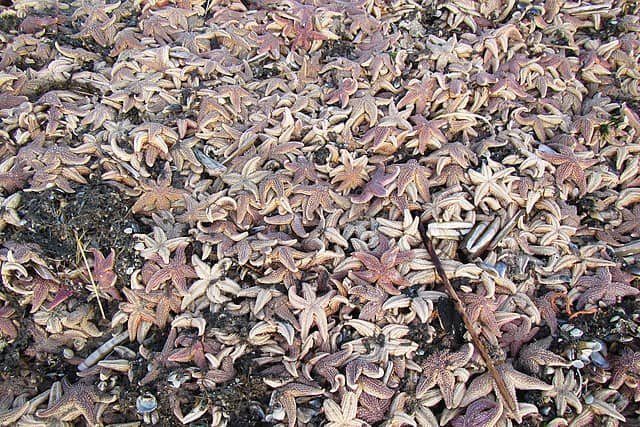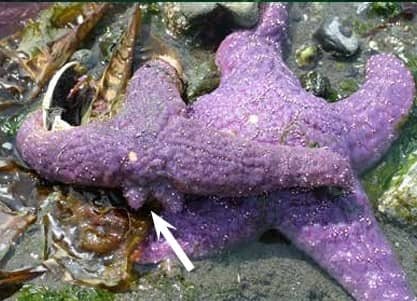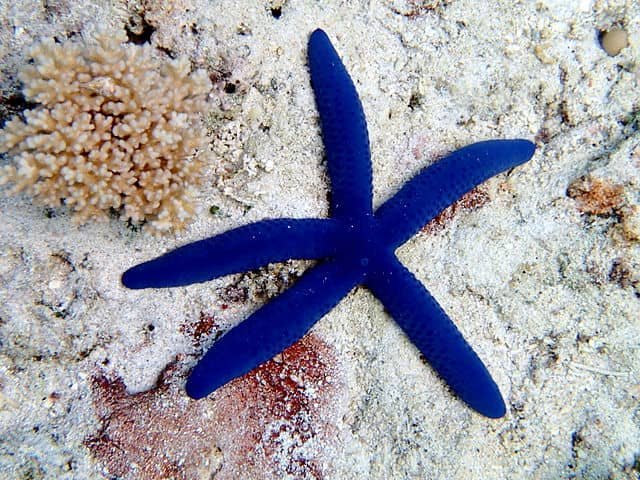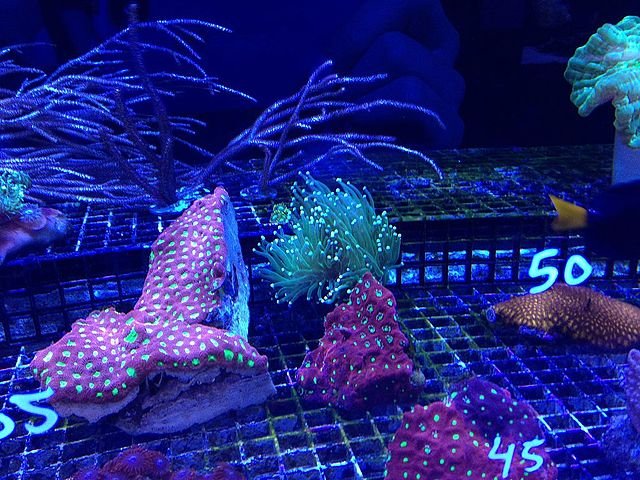
Starfish, or star sea, are iconic marine creatures with significant biological and ecological importance in marine ecosystems.
However, in some cases, star sea proliferations have led to the destruction of coral communities (Smith et al., 2017) and have become a headache for aquaculturists as they threaten mussel bed crops (Calderwood et al., 2016).
On the other hand, starfish have become a subject of research in many chemical and pharmacological laboratories due to the complexity of their secondary metabolites and diverse bioactivities (Dong et al., 2011).
Starfish are commercially dried for use in traditional Chinese medicine; however, they are not consumed by humans.
In this article, we will describe the main characteristics of starfish, types of reproduction, feeding habits, and their rearing in aquariums.
- 1 Characteristics of Starfish
- 2 Taxonomy and Types of Starfish
- 3 Characteristics and Anatomy of Starfish
- 4 How Do Starfish Reproduce?
- 5 Starfish Regeneration
- 6 Larval Rearing of Starfish
- 7 What Do Starfish Eat? – Feeding
- 8 Where Do Starfish Live? – Habitat
- 9 Utilization of Star Sea
- 10 Rearing Starfish in Aquariums
- 11 Starfish Population Control
- 12 Conclusions
- 13 Bibliographic References
- 14 Entradas relacionadas:
Characteristics of Starfish
A common question among those interested in keeping these aquatic animals in their tanks is: What are starfish?
Starfish are marine invertebrates belonging to the class Asteroidea. This class comprises around 1900 species (Stonik et al., 2020) distributed across oceans worldwide.
Taxonomy and Types of Starfish
The taxonomy of starfish is as follows:
Kingdom: Animalia
Stay Always Informed
Join our communities to instantly receive the most important news, reports, and analysis from the aquaculture industry.
Superphylum: Deuterostomia
Phylum: Echinodermata
Subphylum: Eleutherozoa
Class: Asteroidea
Common Name: Starfish or Sea Star
There are over 1900 species of Sea Star, each showcasing its distinctive charm. From the vibrant colors of the “Red Knob” starfish to the enchanting patterns of the “Chocolate Chip Sea Star,” the diversity within this family is astonishing. Some species even possess the remarkable ability to regenerate lost arms, adding another layer of fascination to their already impressive repertoire.
Characteristics and Anatomy of Starfish
Starfish have a central disc and usually possess five arms. However, members of certain families have 10 to 15 arms, while some species like Labidiaster annulatus from Antarctica can have up to 50 arms.

The upper surface of these animals, depending on the species, can be smooth, granular, or spiny. Starfish have ambulacral feet and a mouth at the center of the oral or lower surface.
The size of Sea Star varies from a diameter of less than 1.0 cm (paddle spined starfish) to around 1.0 m (sunflower starfish).
Many species of starfish come in bright colors such as red or orange, blue, gray, or brown.
Can Starfish See or Not?
According to Garm and Nilsson (2014), most known sea star species have a compound eye at the tip of each arm that, except for the lack of true optics, resembles the compound eye of an arthropod; they conclude that it’s an example of an eye that only supports low-resolution vision.
How Do Starfish Reproduce?
A common question among starfish enthusiasts is: How do they reproduce? Starfish can reproduce sexually or asexually. Below, we provide a description of each type of starfish reproduction.
Sexual Reproduction
Most species of Sea Star are dioecious (having both females and males); however, hermaphroditic species also exist.
Each arm of the starfish has two gonads that release gametes into the water. In most species, fertilization is external.
Caballes and Pratchett (2017) investigated the specific responses of each sex of the crown-of-thorns starfish Acanthaster solaris to potential environmental cues for spawning. They found:
- An abrupt temperature change (+4°C) induces spawning in males but not in females.
- Males often spawn in response to the presence of phytoplankton, but females do not.
- The presence of sperm in the water column induces both males and females to spawn.
Asexual Reproduction
Some species of starfish reproduce asexually through the fission of their central discs or by the autotomy of their arms. The type of reproduction depends on the genus.
Starfish Regeneration
The regeneration of arms is one of the most studied processes in echinoderms. Depending on the species, different critical events take place during the first hours/days after amputation.
Certain starfish species have the ability to regenerate lost arms and can grow new ones. Regeneration can last several months or years.
Honeycutt and Pomory (2019) highlight that a salinity of 33 g/kg produces maximum regeneration in the starfish Luidia clathrata.

Larval Rearing of Starfish
Yushun et al. (2017) describe the reproduction and larval rearing of the Sea Star Acanthaster planci. They induced spawning, and the fertilized eggs were incubated and cultured in disinfected seawater.
On the other hand, Murabe et al. (2021) describe the collection of starfish breeders Asterina pectinifera, maintaining adults in aquariums, rearing fertilized eggs and larvae, and inducing larvae to metamorphose into juveniles under laboratory conditions.
According to Yushun et al. (2017), A. planci developed from fertilized eggs to early bipinnaria within a 50-hour period and reached five-armed juveniles after 23 days of rearing. The researchers used diets based on benthic diatoms and oceanic red yeast.
What Do Starfish Eat? – Feeding
Starfish feed opportunistically, preying mainly on benthic invertebrates such as mollusks (clams, oysters, snails, etc.).
However, herbivorous species also exist. Martinez et al. (2017) describe that Sea Star species primarily feeding on algae are classified as obligate herbivores and play a role in controlling algae populations.
But, how does the starfish eat? Or how do Sea Star feed?
Starfish use their ambulacral feet to handle their prey and bring it to their mouths. They can evert their stomach through their mouth and engulf their prey. For example, if the prey is a mussel, the starfish uses its tubed feet to pry open the mussel; then, the starfish excretes its stomach and starts digesting the soft tissues with digestive enzymes from the stomach. Once digestion is complete, the stomach is retracted back into the starfish’s mouth.
Where Do Starfish Live? – Habitat
The habitat of starfish is highly variable. From the rocky shores of temperate waters to the vibrant coral reefs of tropical seas, these resilient creatures have adapted to diverse environments.
Starfish are benthic aquatic invertebrates, living on the seafloor in sandy or rocky substrates.
Utilization of Star Sea
Starfish are utilized by humans in medicine, as livestock feed, and for the marine ornamental industry.
Medicine
Research on starfish has mainly focused on their regenerative capabilities as models for regenerative therapies. However, their potential for disease treatment in humans has also been explored.
Dai et al. (2016) worked with biomaterials extracted from the arms of the Sea Star Archaster typicus and compared their effects on wound healing in vitro and the regeneration of the lower jaw in vivo in zebrafish, concluding that bioactive compounds could induce blastema formation and remodeling and prevent excessive tissue growth.
Zhou & Gu (2000) report that various bioactive substances derived from starfish, such as terpenes, steroids, carotenoids, astroponins, and phospholipase, play important roles in cancer therapy. Siddharthan and Rajamohamed (2020) report the potential of peptides from Linckia laevigata for treating the Candida albicans fungus that affects humans.
Stonik et al. (2020) describe asterosaponins as a class of steroid oligoglucosides isolated from Sea Star with characteristic structures and diverse biological activities, including anti-cancer, antimicrobial, and anti-inflammatory properties.
Kim et al. (2016) worked with the apical muscle of the starfish Patiria pectinifera and identified a myorelaxant peptide.
Feed Ingredients
Kang et al. (2016) used starfish species Asterina pectinifera and A. amurensis in diets to feed trumpet snail (Charonia lampas sauliae) breeders, concluding that the use of A. amurensis led to better feed conversion rates and survival rates.
van der Heide et al. (2021) report that the Sea Star contains 39% crude protein on a dry matter basis, and they mention the use of Asterias rubens starfish meal in the feed of monogastric animals like pigs; however, its use is limited by its calcium content.
Rearing Starfish in Aquariums
Starfish have not yet been domesticated, but some species can be kept in aquariums.
These aquatic organisms prefer tanks with plenty of hiding spots and substrates to explore. Sea Star require maintaining stable water quality and salinity.
The diet of aquarium-reared starfish depends on the chosen species. Clams, mussels, scallops, and oysters are preferred prey for many medium to large starfish, particularly species like the blue starfish (Linckia laevigata) and Chocolate Chip starfish (Protoreaster nodosus).
Blue Starfish Linckia laevigata
The blue starfish is a favorite among marine aquarium enthusiasts; however, it is challenging to care for and is recommended only for experienced hobbyists. Although their normal color is blue, they can also be found in purple, orange, or green hues.
L. laevigata lives solitarily during adulthood, can reach a diameter of 30 cm, and exhibits both types of reproduction.

Chocolate Chip Starfish (Protoreaster nodosus)
The ‘Chocolate Chip’ Sea Star has become famous for its distinctive anatomy, featuring pointed tubercles that vary greatly from individual to individual.
Protoreaster nodosus has five arms and can grow up to a diameter of 40 cm. It feeds on detritus, dead animals, and vegetation.

Starfish Population Control
Uncontrolled increases in starfish populations pose a threat to ecosystems such as coral reefs and bivalve farming systems. Measures are being studied to control their populations.
In mussel farming, when starfish occur in high densities and predation levels are high, aquaculturists must manually remove them (Kamermans and Capelle, 2019).
The crown-of-thorns starfish (Acanthaster spp.) are known for their destructive consumption of corals that devastate reefs (Deaker and Byrne, 2022). In this regard, Kroon et al. (2021), regarding the crown-of-thorns starfish (Acanthaster spp.), recommend that fisheries management (especially of starfish-predatory species) should consider the dynamics of starfish populations to effectively reduce negative impacts.
Conclusions
Although Sea Star pose a threat to corals and bottom-dwelling bivalve mariculture, they play an important role in marine aquatic ecosystems and have the potential to be a source of bioactive compounds for human health.
Furthermore, there is a growing interest in breeding blue and chocolate chip starfish in aquariums, which may stimulate interest in promoting their aquaculture. However, research on their reproduction is needed.
The diversity, anatomy, habitat, feeding habits, reproduction, and intriguing facts about starfish collectively paint a picture of a creature that is a true wonder of nature.
Bibliographic References
Caballes CF, Pratchett MS (2017) Environmental and biological cues for spawning in the crown-of-thorns starfish. PLoS ONE 12(3): e0173964. https://doi.org/10.1371/journal.pone.0173964
Calderwood Julia , Nessa E. O’Connor, Dai Roberts. 2016. Efficiency of starfish mopping in reducing predation on cultivated benthic mussels (Mytilus edulis Linnaeus). Aquaculture, Volume 452, 2016, Pages 88-96, ISSN 0044-8486, https://doi.org/10.1016/j.aquaculture.2015.10.024.
Dai, Y., Prithiviraj, N., Gan, J. et al. Tissue Extract Fractions from Starfish Undergoing Regeneration Promote Wound Healing and Lower Jaw Blastema Regeneration of Zebrafish. Sci Rep 6, 38693 (2016). https://doi.org/10.1038/srep38693
Deaker Dione J., Maria Byrne; Crown of thorns starfish life-history traits contribute to outbreaks, a continuing concern for coral reefs. Emerg Top Life Sci 14 March 2022; 6 (1): 67–79. doi: https://doi.org/10.1042/ETLS20210239
Dong, G., Xu, T., Yang, B., Lin, X., Zhou, X., Yang, X. and Liu, Y. (2011), Chemical Constituents and Bioactivities of Starfish. Chemistry & Biodiversity, 8: 740-791. https://doi.org/10.1002/cbdv.200900344
Garm Anders and Nilsson Dan-Eric. 2014. Visual navigation in starfish: first evidence for the use of vision and eyes in starfish. Proc. R. Soc. B.2812013301120133011 https://doi.org/10.1098/rspb.2013.3011
Honeycutt Nicholas R. & Christopher M. Pomory (2019) Effects of salinity and feeding on arm regeneration in the starfish Luidia clathrata (Say, 1825) (Echinodermata: Asteroidea), Marine and Freshwater Behaviour and Physiology, 52:1, 37-51, DOI: 10.1080/10236244.2019.1629296
Kang, K., Kim, M., Hong, H. et al. Feeding broodstocks different starfish diets affect growth and survival of larvae of trumpet shell (Charonia lampas sauliae Reeve 1844). J. Ocean Univ. China 15, 861–865 (2016). https://doi.org/10.1007/s11802-016-3040-7
Kamermans P. and J. J. Capelle. 2019. Chapter 3 – Provisioning of Mussel Seed and Its Efficient Use in Culture. A. C. Smaal et al. (eds.), Goods and Services of Marine Bivalves. Springer Open.
Kim, C.-H., Kim, E.J., Go, H.-J., Oh, H.Y., Lin, M., Elphick, M.R. and Park, N.G. (2016), Identification of a novel starfish neuropeptide that acts as a muscle relaxant. J. Neurochem., 137: 33-45. https://doi.org/10.1111/jnc.13543
Kroon, F.J., Barneche, D.R. & Emslie, M.J. Fish predators control outbreaks of Crown-of-Thorns Starfish. Nat Commun 12, 6986 (2021). https://doi.org/10.1038/s41467-021-26786-8
Martinez Aline S., Maria Byrne, Ross A. Coleman. 2017. Filling in the Grazing Puzzle: A Synthesis of Herbivory in Starfish. In: S. J. Hawkins, A. J. Evans, A. C. Dale, L. B. Firth, D. J. Hughes, I. P. Smith (edits). Oceanography and Marine Biology. CRC Press.
Murabe N., Okumura E., Chiba K., Hosoda E., Ikegami S., Kishimoto T. (2021) The Starfish Asterina pectinifera: Collection and Maintenance of Adults and Rearing and Metamorphosis of Larvae. In: Carroll D.J., Stricker S.A. (eds) Developmental Biology of the Sea Urchin and Other Marine Invertebrates. Methods in Molecular Biology, vol 2219. Humana, New York, NY. https://doi.org/10.1007/978-1-0716-0974-3_3
Siddharthan, S., & Rajamohamed, B. S. (2020). Investigation of potential antibiofilm properties of Antimicrobial Peptide (AMP) from Linckia laevigata against Candida albicans: An in vitro and in vivo study. Process Biochemistry, 99, 340-347.
Smith Meaghan K., Tianfang Wang, Saowaros Suwansa-ard, Cherie A. Motti, Abigail Elizur, Min Zhao, Matthew L. Rowe, Michael R. Hall, Maurice R. Elphick, Scott F. Cummins. 2017. The neuropeptidome of the Crown-of-Thorns Starfish, Acanthaster planci, Journal of Proteomics, Volume 165, 2017, Pages 61-68, ISSN 1874-3919,
https://doi.org/10.1016/j.jprot.2017.05.026.
Stonik Valentin, Alla Kicha, Timofey Malyarenko and Natalia Ivanchina. 2020. Asterosaponins: Structures, Taxonomic Distribution, Biogenesis and Biological Activities. Mar. Drugs 2020, 18(12), 584; https://doi.org/10.3390/md18120584
van der Heide, Marleen E., Lene Stødkilde, Jan Værum Nørgaard, and Merete Studnitz. 2021. “The Potential of Locally-Sourced European Protein Sources for Organic Monogastric Production: A Review of Forage Crop Extracts, Seaweed, Starfish, Mussel, and Insects” Sustainability 13, no. 4: 2303. https://doi.org/10.3390/su13042303
Wikipedia. Asteroidea.
Yushun Tian, Zonghe Yu, Peng Luo, Long Yun, Wen Huang, Chaoqun Hu, Da Huo & Huo Li (2017) Artificial breeding and culture of the crown-of-thorns starfish Acanthaster planci (Linnaeus, 1758) larvae in China, Invertebrate Reproduction & Development, 61:3, 157-163, DOI: 10.1080/07924259.2017.1315342
Zhou & Gu . Survey of studies on starfish saponins and the other bioactive substances. Marine Science 24, 35–37 (2000).
Editor at the digital magazine AquaHoy. He holds a degree in Aquaculture Biology from the National University of Santa (UNS) and a Master’s degree in Science and Innovation Management from the Polytechnic University of Valencia, with postgraduate diplomas in Business Innovation and Innovation Management. He possesses extensive experience in the aquaculture and fisheries sector, having led the Fisheries Innovation Unit of the National Program for Innovation in Fisheries and Aquaculture (PNIPA). He has served as a senior consultant in technology watch, an innovation project formulator and advisor, and a lecturer at UNS. He is a member of the Peruvian College of Biologists and was recognized by the World Aquaculture Society (WAS) in 2016 for his contribution to aquaculture.




